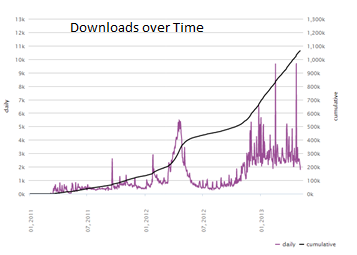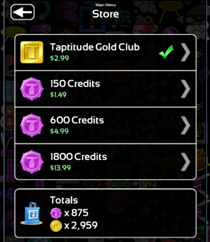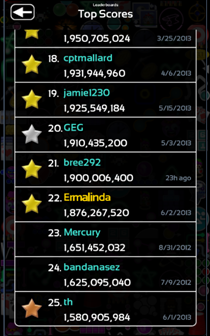What is Taptitude?
Taptitude is a free cross-platform mobile game that delivers over 80 unique mini-games all in one package. It started out as a small collection of relatively simple games, but over the last two years has come a long way. The games we ship in the latest versions have much more depth and replay-ability than the earlier counterparts. Each game has unique upgrade system which allows users to earn and buy virtual goods that change their game. These range from simple collectable items that are mostly decoration, to game changing abilities and items to help them earn better scores. Taptitude has over 600 of these upgrades for users to earn or purchase.
The cross-platform and worldwide leaderboards allow the users to compete for the highest scores in each mini-game. We also provide leaderboards on every individual statistic in the game, of which there are over 100! The stats range from simple measures like "Total Play Time" to very specific stats like "Most Fish" in a popular fish collecting game.
We designed Taptitude with In App Purchase in mind, allowing them to enhance the gameplay but not require it. In this article we will discuss different monetization options, how to enhance your application with IAP, and some examples that we chose to use in Taptitude.
Paid vs Free vs IAP
Assuming one of the goals of an application is to make money, deciding how to monetize is very important. The first decision, perhaps the most important one, is if the application should be free or paid. It helps to try and understand how you expect the application to be used, since this can impact how you monetize.
Paid Apps
Typically a paid app model works well for applications that perform a specific, perhaps rarely used, task. One example of an application that would fit into this category is a tip calculator app, where it is only going to be used when they are out to eat at a restaurant, and will only have the application open for a few seconds while the tip is calculated. In this situation, a free application that makes money from ads will get few impressions per user, and less total income.
Paid apps often have less downloads and spread less easily. We first released Taptitude as a paid application and found that it was very hard to get new users. This is because most users are not willing to try out a paid application, even if there is a trial. Similarly, it is difficult to tell your friend about a paid application and have them download it they are required to pay for it on the spot.
Free Apps (Ad supported)
Free apps work well if they are able to keep users in the app for large durations of time. During this time, the application is showing them relevant ads and giving the user the opportunity to click them. This results in more revenue for the application. Addicting games, eBook/comic readers, etc are good examples of apps that consume users time. A good way to think of it is more time = more money.
Free apps are much easier to attract new users. When we moved Taptitude from paid to free, we saw a dramatic increase in daily new users. This type of app spreads very easily via word of mouth, internet ads, Facebook, etc because it is so easy for anyone to install. Without having a paywall to try the app, more people are willing to download it.
In App Purchase
In app purchases are not mutually exclusive to either free or paid. They can be effectively used in combination with monetizing via paid application or ad revenue. Taptitude is a free application that makes money through ad revenue. Recently we added the option to spend money on In App Purchases as supplemental revenue. Unlike ads, which can vary day-to-day based on market demand, IAP is generally more stable.
Selling a single IAP can result in more profit than ad revenue from even a large set of users. Based on our data, it would take over 60 users using the application for 30 minutes each to equal a single 99c purchase (25c for 1000 ads, would take 4000 impressions to equal a dollar, showing 2 ads a minute that’s 2000 minutes of play time total. 2000 / 30min = 66 users).
The next section contains tips on how to use In App Purchases within an application.
+Enhance, -Restrict
The key takeaway we have gotten from Taptitude is to enhance the gameplay with in-app-purchases, and not to restrict it. We allow the users to earn nearly everything in our game without spending any money. Users can enhance the experience by purchasing the items without earning them, but are not required to do so.
With Taptitude, our goal is to get users hooked on our game without feeling like they have a hard time-limit on their fun. Many games and apps will put artificial restrictions unless you make in-app-purchases. This can restrict the amount of fun a user has, which in turn may result in less widespread adoption, less downloads, and ultimately less long-term money.
Another way to enhance your app without ruining the experience is to provide in-app-purchase customization options. This includes items that allow users to "show off" including: special icons, leaderboard name effects, outfits for characters, etc.
Lastly, try not to use in-app-purchases to create a "pay to win" environment. For games, this means the competitive leaderboards need to remain competitive to everyone including those who did not spend any money.
Cross Platform
Taptitude ships on all major mobile platforms. This includes Windows Phone 7, Windows Phone 8, Android, iPhone and iPad. To add to this complexity, we update the application every week with new content, games, upgrades, etc.
Because of the regular updates on multiple platforms, we had to design our game around code reuse. 90+% of our code compiles untouched with no special cases on the different platforms. The remaining 10% is abstracting out into different platform interfaces (certain threading APIs, email/web tasks, in-app-purchase, etc).
Although our store model and visuals are all the same across the different platforms, the APIs for in-app-purchase vary for each major platform. In-app-purchase feature sets are also not the same between platforms, and need to be thought out before going cross-platform.
Some differences include
- Consumables (items which can be repurchased over and over, can have quantity) do not work the same way across different platforms. Specifically, Windows 8 does not have consumables but does have a time-based expiration on items which can simulate consumables.
- Durables (items which are only purchased once and are owned forever) are not all the same across platforms. Again, some have expirations on the liscense others do not.
- Subscriptions (monthy payments) are not supported on all platforms. Windows Phone does not support subscriptions at this time.
- Free purchases (durable/consumable without a price) are not supported on all platforms. iOS and Android do not support free purchases.
- Ways to store information like quantity are different per platform. On Windows Phone each item can include a blob of data (Tag) which can store arbitrary data. We used this to store JSON object containing the rewards and quantity of each. This is not available on iOS, Android, or Windows 8.
Examples
In-App-Purchases can be used in many different situations and application specific ways. In Taptitude we chose a simple set of upgrades which we will go over here.
Taptitude also provides a free Starter Pack for new users. Having a free purchase helps drive traffic into the store, and gets the users accustomed to purchasing things.
Our Taptitude Gold in-app-purchase is a durable which provides many benefits. By purchasing this upgrade, they are entered into the exclusive gold club which removes the ads from the game and customizes their leaderboard entries with a flashy gold effect. The price point on an upgrade which removes the ads needs to be well thought out, and depends on how "sticky" your application is. Although the average user will only provide a handful of ad impressions, the most hardcore users (those most likely to purchase this) can provide the most ad impressions. Taptitude's top 5 longest players have over 100 days of in-game time spent. Showing ads 2 times per minute, that's over 288,000 ads per user over the lifetime of Taptitude! Using the same math as before, this can equal upwards of 70 dollars for a single user.
Lastly, Taptitude sells in-game credits which can be used on any of the 600+ upgrades as well as other per-game specific enhancements.



